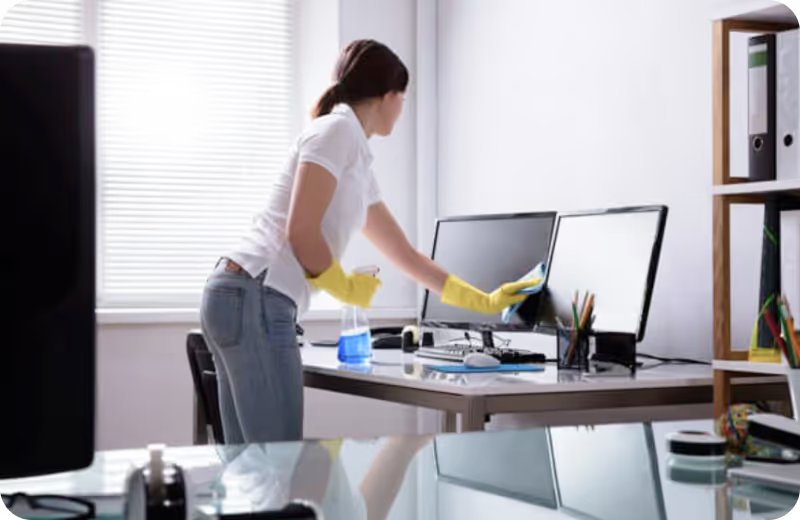
What’s more relaxing than a long soak in a warm bath after a tiring day? A bathtub is an essential fixture in your home that can make self-care days all the more enjoyable. However, a plastic bathtub can get especially dirty due to mineral deposits in the water, body oils and dead skin, soap scum, mold, and more.
Preserve your self-care days and maintain your bathtub with regular cleaning. Plastic tubs are made from resilient acrylic material that can withstand a wider variety of cleaning solutions than other materials can. In this guide, we’ll look through different types of common bathtub grime, and ways to get rid of them using common household staples.

How to Clean a Plastic Bathtub
While commercial cleaning products are formulated to keep your plastic bathtub looking shiny and presentable, homemade cleaners work just as well to DIY your cleaning routine. These recipes are not only inexpensive, they are mild on the skin so you can enjoy soaking in your tub to the fullest.
For Mold: Use Lemon Juice and Baking Soda
To combat mold, use a mixture of equal parts fresh or bottled lemon juice, and water in a spray bottle. Add in 2 tablespoons of baking soda and swirl to mix until dissolved. Spray the mixture around mold spots and let the solution sit until dry.
Apply another layer of spray and use a soft-bristled brush or an old toothbrush to scrub away the mold and mildew spots. Rinse out your bathtub and repeat the process if necessary. This spray can also be used to prevent mold from growing. Simply spray a layer of the solution to prevent mold and mildew from growing.
For Soap Scum: Use Dish Soap
Using soap to remove soap scum? That may sound like an oxymoron, but dish soap works differently than our bath soaps. Mix 2 tablespoons of Dawn dish soap in a spray bottle of warm water, and swirl to incorporate. Spray the mixture wherever there is soap scum, and let the solution sit for 15 minutes.
Use a soft-bristled brush, like an old toothbrush to scrub away the scum, and rinse the bathtub with warm water. Repeat as needed. This solution also makes for a terrific daily cleaning solution you can use to remove dirt from your bathtub during routine cleaning sessions.
For Hard Water Stains: Use White Vinegar
Diluted white vinegar dissolves the mineral deposits in hard water that causes chalky-white rings around your bathtub. Fill a spray bottle with equal amounts of water and distilled vinegar, and use this spray to cover your bathtub. Focus on areas where stains are prevalent.
Use a sponge to scrub out the loosened mineral deposits, and rinse the tub with water. Your bathtub is now spotless and ready for use. Use the same solution to clean your faucet and drain too, for a full-on cleaning day.
How to Clean and Remove Plastic Bathtub Stains
Tough stains seemingly made permanent residence on your tub? Don’t be dismayed, as you can take care of the problem at home using a few household staples, and a little more effort.
Use Baking Soda and Hydrogen Peroxide
A paste made from sodium bicarbonate and hydrogen peroxide can remove tough stains from your bathtub. Mix baking soda with enough hydrogen peroxide to form a thick paste, and apply the paste on stubborn stains. Use a sponge or a soft-bristled brush to scrub the gentle abrasive into the surface without scratching it.
Let the paste sit until dry, then rinse out the tub with warm water, or wipe any excess off. Repeat until all stains are gone. You can also use this solution to clean tile and grout.
Use Bleach to Whiten Tubs
Bleach should only be used on white bathtubs, but can make your tub gleam and look pristine again. Use bleach diluted with water for light stains, undiluted for heavy stains. Simply apply the bleach directly on stains, and let it sit until the stain disappears. Make sure to rinse off the bleach before using the tub to prevent skin irritation.
How to Clean a Plastic Shower
Cleaning an acrylic or plastic shower is no different from cleaning a plastic bathtub. All you’ll need are the cleaning solutions mentioned above, and a little time and effort to get your shower sparkling and spotless.
Clean the Shower Head
The shower head gets mold and rust from time to time due to constant exposure to moisture. Acrylic shower heads are durable and long lasting, but mold and water damage can greatly affect its lifespan. Thorough cleaning is a must to keep your shower head in good condition.
To clean, use a mixture of vinegar and sodium bicarbonate for a fizzy liquid soak that will loosen grime overnight. Attach the mixture in a plastic bag to the shower head, ensuring it is fully soaked in the liquid. Secure the plastic bag with rubber bands and leave overnight. The next morning, scrub the pores of the shower head with an old toothbrush and run the water to rinse.
Clean the Shower Floor
The shower floor is where dirt and grime washes away, so it can get particularly mucky when not cleaned regularly. Use a solution of dish soap and water for a spray that can be used daily when cleaning the shower floor. Spray the solution all over the floor, including on the grout and around the drainage area. Scrub with a brush and rinse.
Clean the Shower Walls
A gel-type cleaner works best for walls as it will not run off like other liquid cleaners will. Make a gel cleaner using 6 tablespoons of cornstarch mixed in 2 cups of water, heated over a stove until thickened. Remove from heat and add in 12 tablespoons of bleach. Use this gel to clean spots in your shower walls, and make them look white and bright again.
How Often Should I Clean My Bathtub?
Bathtubs are not as often used as showers, but can still accumulate as much dirt due to the humid environment around them. A bathtub would need a weekly cleaning schedule to ensure that it is in good working order and in pristine appearance.
Too busy to maintain a cleaning schedule? Our professional part time maids in Singapore can clean your house top to bottom, ensuring not a single speck of dust is left. Book an appointment and we can discuss a regular cleaning schedule that works for you!


























